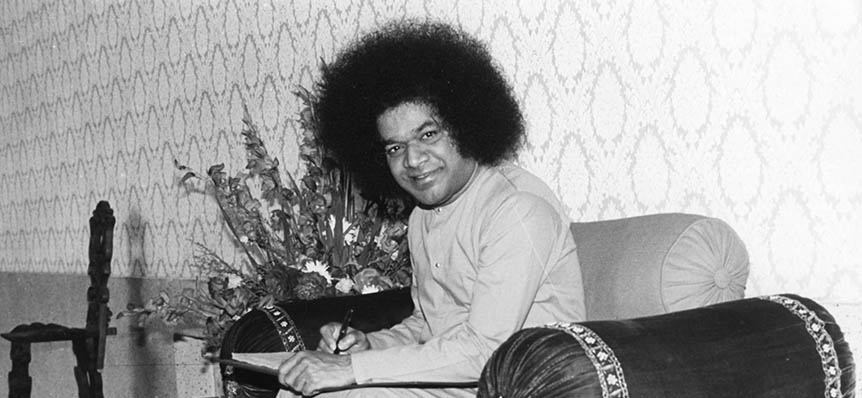

Baba speaks of Himself as the mother yearning to feed an unruly child who, in its ignorance, refuses to eat what will cure its hunger. The child has to be coddled and coaxed, wheeled and petted, even caught unawares sometimes by means of a story or a song, to induce it to accept the food it needs. Baba's immeasurable Love, persuades Him to pack a medicinal dose in a sweet smile, a panacea in a palatable parable or a profound thought in a syrupy joke. Let us dip into the books Baba has given Mankind in order to draw it to the feast that He has prepared for its hunger. His books are an invitation to His presence, fresh and fascinating as they are.
Baba writes in simple and elegant, colloquial Telugu or English prose. The message is always extempore, His ideas receiving expression as mellifluous poems and songs, showering exquisite delight. Poetry and melody shine through each sentence and behind each phrase and clause lays a form that is apparently human, but is suffused with Divine Wisdom.
All the immortal pieces flowed from Baba’s pen as articles for the Ashram magazine ‘Sanathana Sarathi’ (The Eternal Charioteer) during its early years. Prof. Kasturi, the first editor of Sanathana Sarathi, who used to collect material from Bhagawan every month for the magazine, narrates the following remarkable experience regarding Bhagawan’s Omniscience and the innate simplicity with which Bhagawan wrote the Vahinis.
“Baba decided on a small book on the Upanishads, the Upanishad Vahini, in order to rivet the world to the efficacy of Vedanta. As editor of the magazine, which published serially the chapters of this book, I had an amazing experience, every month. After dispatching the magazine on the 16th of every month, I would go to him for the next part of the series. Announcing the name of the Upanishad Himself, He would ask me to wait for a while in His room and proceed along the verandah with a notebook and pen, towards the room where they stood a table with a chair by its side and nothing else besides.
Once, it was the turn of the Brihadaranyaka Upanishad, to be summarized and simplified. It is the biggest and the profoundest of the ten. I am certain that Baba had never read it or consulted others who could talk on it. And there was no copy available anywhere within miles. But forty minutes after he moved out with a pen and the notebook as His sole possessions, I could descend the eighteen steps from His room with a ten-page dissertation on the truths this Upanishad enshrined! I peeped into the script as I walked towards the Press and my eyes fell on the Telugu words, which said, ‘the grandeur of the intellect of Sage Yajnavalkya is impressively evident in this Upanishad’. I told myself, the grandeur of the Omniscient teacher that Baba is, is now impressively evident to me.”
It was Prof. Kasturi who collated all the articles that Baba had written for the ‘Sanathana Sarathi’, the Ashram Periodical, and brought out in a book form as the “Vahini Series” as Baba used to title all His articles as Vahinis. Vahini meaning flow or stream.
There are 15 vahinis in all, written in Telugu by Baba and translated into English by Prof. Kasturi. The Vahinis like ‘Prema Vahini’ and ‘Dhyana Vahini’ are little gems, classics of the spiritual life from the moment that Baba wrote them. Their simplicity, which, at the same time, contains such a depth of meaning, is unique. They speak of Peace, Meditation, Love and Wisdom. They seek to acquaint the reader with the Upanishads and the Gita. In a class by itself stands ‘Sandeha Nivarini’, the Doubt Dispeller. It raises various metaphysical problems and answers them.
Prema Vahini - The Stream of Divine Love
Dhyana Vahini - The Practice of Meditation
Dharma Vahini - The Path of Virtue and Morality
Jnana Vahini - The Stream of Eternal Wisdom
Gita Vahini - The Divine Gospel
Prashanthi Vahini - The Supreme Bliss of the Divine
Sathya Sai Vahini - Spiritual Message of Sri Sathya Sai
Ramakatha Rasa Vahini - The Sweet Story of Rama’s Glory
Sandeha Nivarini - Clearance of Spiritual Doubts
Leela Kaivalya Vahini - The Cosmic Play of God
Sutra Vahini - Analytical Aphorism on Supreme Reality
Vidya Vahini - Flow of Spiritual Education
Upanishad Vahini - Essence of Vedic Knowledge
Bhagavatha Vahini - The story of the Glory of the Lord
Prasnothara Vahini - Answers to Spiritual Questions
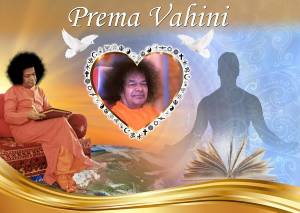 Baba has said that if He were to be identified by one characteristic more than any other,
He could most aptly be called ‘Prema Swaroopa’, the Embodiment of Love. The very first Vahini (stream) that flowed forth from his pen to fertilize the mind of man was the book, ‘Prema Vahini’.
Narada, the great exponent of love as a spiritual discipline, defines the path of love as equivalent to supreme devotion. The love is described as Supreme, because it is full and free, with
no conditions, no trace of bargaining, no taint of fear. Once such love is practiced and experienced all distinctions drop, duality ceases and only the truth remains.
Baba has said that if He were to be identified by one characteristic more than any other,
He could most aptly be called ‘Prema Swaroopa’, the Embodiment of Love. The very first Vahini (stream) that flowed forth from his pen to fertilize the mind of man was the book, ‘Prema Vahini’.
Narada, the great exponent of love as a spiritual discipline, defines the path of love as equivalent to supreme devotion. The love is described as Supreme, because it is full and free, with
no conditions, no trace of bargaining, no taint of fear. Once such love is practiced and experienced all distinctions drop, duality ceases and only the truth remains.
Baba quotes the love of the simple milkmaids and cowherds of Brindavan towards Krishna as the best example of this parama prema (Supreme Love). Krishna Himself appreciated it thus: they long for Me so deeply, their thoughts, words and deeds are so imbued with Me, that they have no sense of time or space, no consciousness of their bodies and their needs. They are so absorbed in Me that they are like rivers that have merged in the ocean and lost their individual names and distinctions.
Baba says in Prema Vahini only through love can faith become steady; only through faith can knowledge be gained; only through knowledge can parabhakthi (complete devotion, self surrender) be ensured and only through parabhakthi can the Lord be realised.
To read ‘Prema Vahini’ online, Click here.
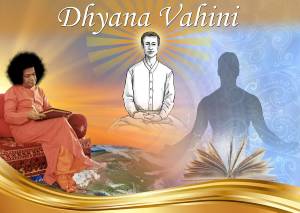 Today quacks with new-fangled ideas lay down rules for Dhyana (Meditation), says Baba. Each one has
his own special prescription and claims that his system can confer more benefit than that of others. But none have themselves experienced its sweetness of sanctity. That is the real reason
why Dhyana has drawn out upon itself the cynical laughter of many. My intention is to instruct such people and guide them on the right path.
Today quacks with new-fangled ideas lay down rules for Dhyana (Meditation), says Baba. Each one has
his own special prescription and claims that his system can confer more benefit than that of others. But none have themselves experienced its sweetness of sanctity. That is the real reason
why Dhyana has drawn out upon itself the cynical laughter of many. My intention is to instruct such people and guide them on the right path.
Baba goes on to reveal in these words the origin of His book, ‘Dhyana Vahini’. Even the most potent drug will not cure when it is only extolled in elaborate phrases at the bedside of the patient. The drug must be taken in and allowed to walk its way into the blood stream. Your reading what I write on Dhyana will not make it easier. The mind is a mad pleasure seeker, running after mirages seen through the inefficient and therefore, deceptive senses of perception. The multifarious desires that infect the mind have to be quelled and the mind focused on Ananda (bliss) only. Of course, it will itself turn to God. When knowledge is accepted as the master, when the mind is denied the food that breeds depravity, when the senses are tamed by firmness and faith, Dhyana will surely lead you to that Goal.
Baba distinguishes between concentration, contemplation and meditation. Concentration is an unwavering determination in one's daily life, in the realm of the senses, the feelings and the intellect. Contemplation is achieved when the senses withdraw for some time and attachment to the objective world slackens, when you have completely broken away from all attachment, you enter a state of meditation, says Baba.
Baba gives the guidelines for meditation and mind control in Dhyana Vahini. He says that Dhyana is as life sustaining as dhanya (food). Baba explains the choice of place, posture, time-table and the curriculum, but lays greater stress on the compassion of the Lord who responds to the prayer embodied during Dhyana.
Since God assumes, for the sake of the sadhaka, the name and form that he meditates on, Baba assures us that Dhyana need never be a barter endeavour; the summit can be reached by perseverance, for He rises up to Himself the struggling and the exhausted.
Baba warns us against nine enemies that waylay the earnest sadhaka. Three of them are physical: adulterous urges, greed to possess things or gain exclusive love and the tendency to injure living beings; three are verbal: delight in causing panic by false alarm, speaking lies and spreading scandal; and three are mental: craving for what belongs to others, envy and cynicism.
Baba directs that the meditation on the form be accompanied by an unbroken absorption of the sweetness of the name by which that form is identified. When the form slips from attention, the name will soon bring it back; when the name drops from awareness, the form will restore it to the mind. Thus, the constant presence of God in the consciousness is ensured, says Baba.
To read ‘Dhyana Vahini’ online, Click here.
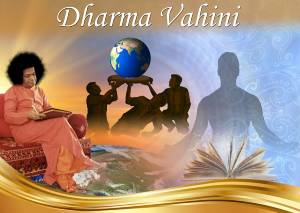 Baba says, Dharma (Right Conduct) is like the river Saraswati, flowing unseen beneath the deeper
levels of human consciousness, feeding the roots of activity, filling the springs of thought, cleansing the slushy eddies of feeling. When the river runs dry or is clogged by greed and hate,
the avatar comes to let in a torrent of grace and restore its fresh, free flow.
Baba says, Dharma (Right Conduct) is like the river Saraswati, flowing unseen beneath the deeper
levels of human consciousness, feeding the roots of activity, filling the springs of thought, cleansing the slushy eddies of feeling. When the river runs dry or is clogged by greed and hate,
the avatar comes to let in a torrent of grace and restore its fresh, free flow.
Baba in Dharma Vahini has installed dharma on an unshakable foundation as the unity of all life, indeed, of creation: Whoever conquers the ego and overcomes the natural tendency to regard the body and its furniture as his true self, is surely on the path of Dharma, for he would soon discover the truth behind all the scintillating multiplicity. He would realise that the objective world is like a gem-studded wheel, over Brahman, which is the one and only truth. Sarvam Khalvidam Brahman (All is verily Brahman, God).
When man is aware of this truth, there will be no other; all will be you. Since you love yourself most, your love will flow in full measure towards all and encompass the living and the non-living. Dharma has to be built on the deep understanding of the depths of Being. Build your life, says Baba, on the Atmic plinth, the faith that you are a wave upon the ocean of bliss, a spark of the cosmic intelligence.
Then He asks, When you worship an idol, what is it that you really do? First, a form of God is imprinted on your mind, after that, you meditate on His Power, Grace and Omnipresence and project these qualities upon the idol, thus enabling your consciousness to transcend it and become unaware of the lithic substance before you.
In the same manner, imprint on your consciousness that form of God which delights you most and fills you with illumination and project that form on every man, beast, bird and insect, on every tree and plant, on every rock and hill; this sadhana (spiritual practise) will make you true, good and beautiful. This is the fundamental norm: Atmic awareness - the unceasing remembrance of the One appearing to be many.
To read ‘Dharma Vahini’ online, Click here .
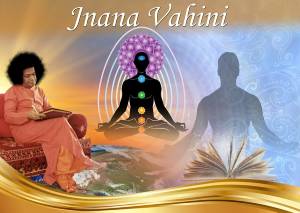 Whenever the gross and even the subtle are transcended, when the intelligence is clarified, when
the self is free from feelings, impulses and instincts, what remains in the consciousness is the true self only. The person, then, is one with Eternal Truth, the One beyond everything. He
becomes Brahman or Paramatman says Baba. This awareness is the acme of Ananda (or bliss).
Whenever the gross and even the subtle are transcended, when the intelligence is clarified, when
the self is free from feelings, impulses and instincts, what remains in the consciousness is the true self only. The person, then, is one with Eternal Truth, the One beyond everything. He
becomes Brahman or Paramatman says Baba. This awareness is the acme of Ananda (or bliss).
In the Taittriya Upanishad it is declared that, from Ananda all this is born and through ananda all this lives, in Ananda all this is merged, and in Ananda all this rests. The greater the awareness of Paramatman (Supreme Divinity), the more the Ananda.
Baba summarises the Truth in one sentence. Awareness is Life and then goes on to reveal that all men are Divine like Myself: the only difference is that they are yet unaware of their divinity. They have come into this karmic prison through the karmas of many lives. I have taken to this mortal form out of My own free will. They are bound to the body, while I am free of this bondage.
To read ‘Jnana Vahini’ online, Click here.
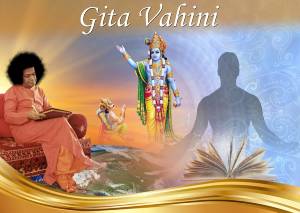 Baba's Geetha Vahini is the holy Bhagavad Gita retold in order to save modern man from
the myopia of egoistic materialism. It is not a resume or a commentary or an abridgement. It is the voice of Krishna Himself, ringing over the clash of hate and greed and calling us into
more worthwhile victories. He has declared that He has come to unify and clarify, fructify and fortify the holy aspirations of man. The doubts and delusions, which torment us while we are
engaged in the battle with our outer and inner kith and kin, are treated here with love and sympathy by Sai Krishna, who also provides us with the answers.
Baba's Geetha Vahini is the holy Bhagavad Gita retold in order to save modern man from
the myopia of egoistic materialism. It is not a resume or a commentary or an abridgement. It is the voice of Krishna Himself, ringing over the clash of hate and greed and calling us into
more worthwhile victories. He has declared that He has come to unify and clarify, fructify and fortify the holy aspirations of man. The doubts and delusions, which torment us while we are
engaged in the battle with our outer and inner kith and kin, are treated here with love and sympathy by Sai Krishna, who also provides us with the answers.
We are encouraged in Geetha Vahini to offer Baba the prayer he puts into the heart of Arjuna (in the great epic Mahabharata) – ‘as You are guiding this chariot, guide me also and show me the way’ - for, He is in fact the charioteer installed in everybody. The Geetha, as expounded by Baba, is a textbook of Yoga and a guide for spiritual practise. It is a yoga shastra and Brahma vidya (Knowledge of the Self) rolled into one. Through smile and story, sneer and laughter, banter and reprimand, question and counter-question, Baba pours into us the nectar of wisdom in this beautiful volume.
At Kurukshetra (the battleground in Mahabharata), Krishna said that the mind and its vagaries could be tamed by Abhyasa (discipline) and Vairagya (detachment). In Geetha Vahini, Sai Krishna adds Vichara (discriminative reasoning). Baba also analyses the concept of Kshetra (place), Yagna (sacrifice), Yoga and Maya (illusion) and sheds light on many corners, which the lamps of ancient masters did not illumine. The ideal of Nishkama Karma, (selfless action), gets a glow of heroism when He interprets it as a conscious refusal of the fruits of activity, a courageous turning away from both triumph and failure.
There are many passages on ‘Geetha Vahini’ of self-revelation by Baba, where it becomes difficult to determine who is speaking to us so intimately Krishna or Sai? How can I ever forget Him who never forgets Me? is the question, Baba asks. Forgetting is a human frailty. Let me tell you, there is no need for Yoga, Tapas (penance) or even Jnana (wisdom). I only ask you to fix your mind on me, dedicate it to me. That is all I demand and all that you need to do, says Baba.
This is the promise of Grace, which all devotees can hope to receive. Grace revives us when we are in great pain and restlessness. It revives us when we totter through the great alleys of our meaningless and empty lives. It revives us when our disgust for our own being, our own indifference, our weakness, our hostility and our total lack of direction and composure has become intolerable.
It revives us when year after year, the longed-for perfection does not appear, when the stale compulsions reign within us as they have done for decades, and when despair destroys all joy and courage. Sometimes, at that moment, a wave of light breaks into our darkness, saying, You are accepted.
Geetha Vahini also condemns fanatic, blinkered gurus and pompous exponents of the Geetha whose oratory sounds hollow because they do not themselves practice what the Geetha preaches.
To read ‘Gita Vahini’ online, Click here.
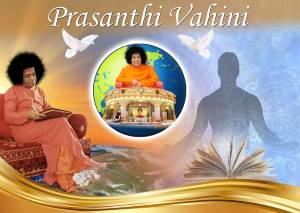 Baba's book Prasanthi Vahini, gives us the key to the treasure house of that peace which
escapes understanding and defies logic, namely ‘Prasanthi’ (or supreme peace), which the Gita calls the goal of human endeavour.
Baba's book Prasanthi Vahini, gives us the key to the treasure house of that peace which
escapes understanding and defies logic, namely ‘Prasanthi’ (or supreme peace), which the Gita calls the goal of human endeavour.
‘Santhi’ means peace unaffected by desire, greed, hatred or anger. It is not curtailed by adversity or multiplied by windfalls. Baba says that we must cultivate the three virtues of viveka (intelligence), vairagya (detachment) and vichakshana (discrimination) in order to equip ourselves with Prasanthi. He prescribes the Viveka Chudamani, composed by Adi Sankara, as the text, which can develop in us these three virtues.
Baba says, Like the children playing with dolls you, too, call some beings elephants and others horses, some friends and others enemies, and spend your entire life in such make-believe. Once you realise that without the spirit they are the same inert substance, the notion of many and the diversity of name and form, both disappear, and there can be no liking and disliking any more. You laugh and weep, love and hate, live in joy, sorrow, anger and fascination, but all these varied reactions do not make the objective world less unreal.
Vairagya (detachment) gets a new meaning in Prasanthi Vahini. ‘Raga’ means attachment and vairagya comes when you realise that the stone to which you were attached is really god. The stoneness is like a veil cast by your ignorance upon what is really of the same substance as you yourself. The vairagya that results from this illumination is lasting and most sublime, Baba explains.
To read ‘Prashanthi Vahini’ online, Click here.
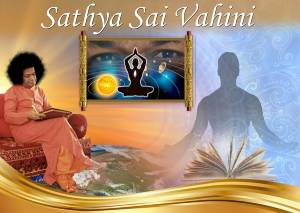 Bhagawan has announced Himself as the Divine Teacher of Truth, Beauty and Goodness. By precept
and example, through His writings and discourses, letters and conversations, He has been instilling the supreme wisdom and instructing all mankind to translate it into righteous living, inner
peace and universal love.
Bhagawan has announced Himself as the Divine Teacher of Truth, Beauty and Goodness. By precept
and example, through His writings and discourses, letters and conversations, He has been instilling the supreme wisdom and instructing all mankind to translate it into righteous living, inner
peace and universal love.
When the ‘Ramakatha Rasavahini’, the uniquely authentic nectarine stream of the Rama story, was serialised in full in the ‘Sanathana Sarathi’ (the ashram monthly), Bhagawan blessed readers with a new series, which He named ‘Bharathiya Paramartha Vahini’ (The Stream of Indian Spiritual Values). While these precious essays on the basic truths, that foster and feed Indian culture since ages before history began, were being published, Bhagawan decided to continue the flow of illumination and instruction under a more comprehensive and meaningful name, ‘Sathya Sai Vahini’ —the holy stream from the Lotus Feet of the Lord—“The Flow of Divine Sai Grace.” This book, therefore, contains the two Vahinis that have merged in one master stream.
Inaugurating these series, Bhagawan wrote, for publication in the Sanathana Sarathi, “Moved by the urge to cool the heat of conflict and to quench the agonising thirst for ‘knowledge about yourself’ that you are afflicted with, see, here it comes, the Sathya Sai Vahini, wave behind wave, with the Sanathana Sarathi as the medium between you and me.”
With infinite compassion, this Sathya Sai incarnation of the Omniwill is giving millions of persons in all lands freedom from disease, distress and despair, narcotics, narcissism and nihilism. He is encouraging those who suffer gloom through wilful blindness to light the Lamp of Love in order to see the world and the Lamp of Wisdom to see themselves. “This is a tantalising true-false world. Its apparent diversity is an illusion. It is One, but is cognised by the maimed multiple vision of humans as Many,” says Bhagawan. This book is the twin Lamp He has devised for us.
‘Sathya Sai Vahini’ reveals to us in unmistakable terms that the self in man is “no other than the Overself or God.” We are told that this is true not only of mankind but of all beings, everywhere and anywhere. In fact, “Will causes this unreal multiplicity of Cosmos on the One that He is. He can by the same Will end the phenomenon.” “Being (God) is behind the Becoming and Becoming merges in Being. This is the eternal Play,” says Bhagawan.
To sum up, the ‘Sathya Sai Vahini’ is the holy gospel given to us by the Person who, as The Eternal Charioteer, is eager and ready to hold the reins of our senses, mind, consciousness, ego and intellect, and guide us safely to Prasanthi Nilayam, the Abode of Supreme peace, the goal of all mankind.
To read ‘Sathya Sai Vahini’ online, Click here .
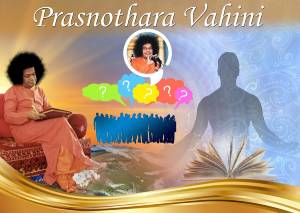 Prasna means “question.” Uttara means “answer,” and Vahini indicates “a stream.” This book
is the stream of the questions that have evoked answers from Bhagawan Sri Sathya Sai Baba. Among the tasks that Bhagawan has assumed while incarnating, He has declared as basic, the one which
He calls, “the clarification and purification of the religious scriptures of mankind.” Every Vahini emanating from Him has done this service to some aspect or other of the spiritual upliftment
of man.
Prasna means “question.” Uttara means “answer,” and Vahini indicates “a stream.” This book
is the stream of the questions that have evoked answers from Bhagawan Sri Sathya Sai Baba. Among the tasks that Bhagawan has assumed while incarnating, He has declared as basic, the one which
He calls, “the clarification and purification of the religious scriptures of mankind.” Every Vahini emanating from Him has done this service to some aspect or other of the spiritual upliftment
of man.
This Vahini is one of the earliest in the series, since it seeks to elucidate the fundamental concepts and precepts of religion, especially the technical words and expressions that seek to concretise them. For some years, this was published as an Appendix to a single Vahini, the Geetha Vahini, but later it was placed in the hands of seekers as a key publication, helpful for readers of all the Vahinis.
The Ancient Wisdom (Sanathana Dharma), the Perennial Path, has been communicated to posterity in words that have suffered distortion, devaluation, dilution and denigration through the efflux of time and the controversies among commentators. Varna (social system based on profession), Asrama (stages of life according to ancient religion), Yoga, Sanyasa (renunciation), Yajna (sacrifice), Karma (action), - these are interpreted by dialecticians and practitioners of varied schools and sects, in confusing and contradictory
versions.Bhagawan has resolved these tangles. His exemplary love and patience sweeten not only every answer but every question too, for, He has, by posturing as the interrogator, made the clarifications full and fruitful.
To read ‘Prasnothara Vahini’ online, Click here.
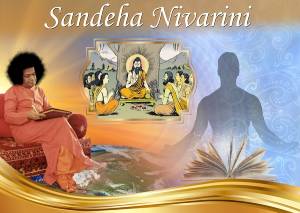 A series of Baba's articles published to remove the weeds of doubt growing wild in the hearts
was collectively entitled ‘Sandeha Nivarini’. Even in his teens and twenties, Baba took delight in prodding those who gathered at His feet to ask Him questions on spiritual matters. These
became the cues for dissertations, short and long, with many an interspersed parable, poem or song, to lead the questioners from darkness to light.
A series of Baba's articles published to remove the weeds of doubt growing wild in the hearts
was collectively entitled ‘Sandeha Nivarini’. Even in his teens and twenties, Baba took delight in prodding those who gathered at His feet to ask Him questions on spiritual matters. These
became the cues for dissertations, short and long, with many an interspersed parable, poem or song, to lead the questioners from darkness to light.
In Sandeha Nivarini Baba says, I am happy when anyone asks Me about the things he has not understood. Of course, you have every right. Then he asks the pupil, but are you reflecting on the answers I give and practicing what has been told you, with the conviction born of faith? What am I here for? Is it not for explaining to you the things you do not know? Ask me without hesitation or fear. I am always ready to answer. Only, the enquiry must be earnest, emerging out of a genuine desire to know and to practice what is good.
It can be revealed now that the bhaktha (devotee) who visits Baba with questions- personal, philosophical and religious in every chapter of Sandeha Nivarini is a creation of the Divine pen. Baba reveals through this character, His infinite compassion towards the samsayatma, the person afflicted with doubts. He poses the problems and provides the answers.
He writes, Bhaktha! I converse with you about every point you place before Me, and allow many to take part in this conversation. The sun's light falls upon the mirror, the light from the mirror upon the walls of the bungalow and the light from the walls upon the eye. Similarly, this Sandeha Nivarini has been planned in order that the illumination of My teaching may fall upon you and thence on to the pages of the ‘Sanathana Sarathi’, so that the effulgence may illuminate the world and bring the light and harmony into the heart of mankind.
To read ‘Sandeha Nivarini’ online, Click here.
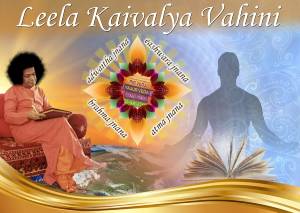 The ‘Vedas’ (ancient Indian scriptures) originated from the breath of God; each syllable
is sacred. Each word is a manthra. It exhorts all men to pursue the same holy desire. All hearts must be charged with the same good urge. All thoughts must be directed by noble motives towards
holy ends. All men must tread the one path of truth for all are manifestations of the One.
The ‘Vedas’ (ancient Indian scriptures) originated from the breath of God; each syllable
is sacred. Each word is a manthra. It exhorts all men to pursue the same holy desire. All hearts must be charged with the same good urge. All thoughts must be directed by noble motives towards
holy ends. All men must tread the one path of truth for all are manifestations of the One.
The world is enchanting, because it is tantalising in appearance, though it is fundamentally untrue. It is a phenomenon which is fading out. When this truth is realised, one becomes aware of the Cosmic Sport of God and the Eternal Universal Being.
‘Leela Kaivalya Vahini’ is a cool crystal clear stream that flows from the Divine pen of Bhagawan Sri Sathya Sai Baba to dissolve all obstacles like doubts and dogmas, purposeless arguments and flimsy fancies of the sadhaka (spiritual aspirant).
These articles, originally published in the ‘Sanathana Sarathi’ (the Ashram periodical), were given a book form and placed at His Lotus Feet on the auspicious occasion of His 65th Birthday, which eventually fell on the 50th year of proclamation of Avatarhood.
To read ‘Leela Kaivalya Vahini’ online, Click here .
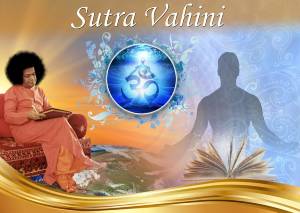 An aphorism (sutra) expresses the genus of its meaning in a few terse words. The Brahma Sutras
systematically explain the basic principles of Vedanta, the science of Supreme Reality. When contemplated, they reveal the innermost metaphysical secrets. Today, harmony is the need of the
hour. The ephemeral world needs spiritual awareness, and this is what the Vedantins (propagators of Vedanta) visualise. Vedic scriptures offer comforting counsel. They throw a kindly light.
An aphorism (sutra) expresses the genus of its meaning in a few terse words. The Brahma Sutras
systematically explain the basic principles of Vedanta, the science of Supreme Reality. When contemplated, they reveal the innermost metaphysical secrets. Today, harmony is the need of the
hour. The ephemeral world needs spiritual awareness, and this is what the Vedantins (propagators of Vedanta) visualise. Vedic scriptures offer comforting counsel. They throw a kindly light.
In the words of Bhagavan Baba, “Acquisition of the higher knowledge alone can fulfill the main purpose of human life. Such knowledge makes one aware that one is not the inert insentient body, etc., but that one is consciousness itself manifesting as the embodiment of being – awareness - bliss (satchidananda). When this truth dawns and is experienced, one becomes a person liberated while alive (jivan-muktha)”. This is the state of realization of the innate nature of a people —the divinity of humanity.
In this Stream of Aphorisms (Sutra Vahini) on Brahman, Bhagavan Sri Sathya Sai Baba has lighted the universal lamp of the wisdom (vidya) of Atma/Brahman (Divine Self). This stream of aphorisms first appeared in serialized form in ‘Sanathana Sarathi’, the Ashram periodical. Bhagavan, in His infinite love, elaborated on the “Essence of Brahma Sutras in twelve selected aphorisms”.
Bhagavan's sublime and profound words and spiritual wisdom are indeed highly elevating and illuminating. Bathing in this pellucid Stream of Aphorisms, a person develops correct or true vision of Reality, bestowing supreme delight.
To read ‘Sutra Vahini’ online, Click here.
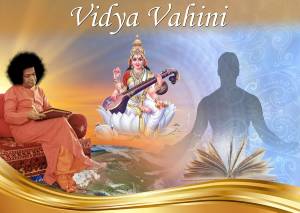 Baba has clarified that the word ‘Vidya’ used for this Vahini (Stream of Thought), means (Ya)
that which (Vid) “illumines.” It is this sense that is highlighted in expressions like Atma Vidya, Brahma Vidya, etc., or even the name Vidyagiri given to the college campus of Prasanthi
Nilayam which comprises the Institute of Higher Learning.
Baba has clarified that the word ‘Vidya’ used for this Vahini (Stream of Thought), means (Ya)
that which (Vid) “illumines.” It is this sense that is highlighted in expressions like Atma Vidya, Brahma Vidya, etc., or even the name Vidyagiri given to the college campus of Prasanthi
Nilayam which comprises the Institute of Higher Learning.
Baba makes us aware of the comparatively less beneficial lower learning which deals with theories, inferences, concepts, conjectures and constructions. The Higher Learning hastens and expands the universal urge to know and become Truth, Goodness and Beauty, Sathyam Sivam Sundaram. Baba has come as Man among men on a self-imposed mission to correct the wrongs inflicted on mankind through the fanatically blind pursuit of lower learning. The human race has to voyage on an even keel; it is leaning too alarmingly towards the briny grave; the lower learning is lowering it into the bottomless pit. ‘Vidya’ alone is the remedy.
From His childhood days, Baba has stood forth as an educator, a Guru as the villagers loved to address Him. He warned, without hesitation, elders at Puttaparthi, teachers in the schools, and headmen of castes against cruelty to animals and exploitation of labour, usury and gambling, pedantry and illiteracy, hypocrisy and pomp. Through gulps and jests, parody and satire, songs and plays, the young teenager Teacher ridiculed and reformed the society which honoured or tolerated such evils. Through Bhajans sung in chorus by groups of men and women, He reminded them of the universal human values of Truth, Morality, Peace, Love and Non-violence as early as 1943, when he was barely seventeen. These were the basic acquisitions that ‘Vidya’, the Higher Learning, can confer on votaries.
As Lord Krishna, He said to Arjuna, “Adhyaatma Vidya, Vidyaanaam” meaning, “Among all the types of knowledge, I am Atma Vidya - the search for Atmic Truth.” The world can be saved from suicide only through this knowledge. The search for Truth and Totality, for Unity and Purity is the means; the Awareness of the One is the consummation of the process.
This Message is the sum and substance of every Discourse of His, from the time He first spoke in the early 1950s. This precious book provides us the chance to peruse nineteen essays He wrote in answer to appeals for the elucidation of the principles which must guide us while rehabilitating Education as an effective instrument for establishing peace and freedom in us and on Earth.
To read ‘Vidya Vahini’ online, Click here.
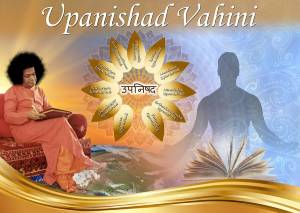 Upanishad Vahini is a synoptic review of the ten principal Upanishads with a prologue and an epilogue
on the rare text called the ‘Brahmanubhava Upanishad’. These Upanishads are esoteric and highly cryptic, but they elucidate the highest truths discernable to the intellect of Man.
Upanishad Vahini is a synoptic review of the ten principal Upanishads with a prologue and an epilogue
on the rare text called the ‘Brahmanubhava Upanishad’. These Upanishads are esoteric and highly cryptic, but they elucidate the highest truths discernable to the intellect of Man.
Vedic literature is classified as ritualistic, consecrational and metaphysical (karma, upasana, jnana), and the Upanishads are grouped under the third category. But Baba says that each principal Upanishad deals with all the three and is, therefore, instructive for all types of spiritual aspirants. Besides special rites described in most of them, the adoration of preceptors or deities is also recommended.
Baba says, The Upanishads enshrine the whisperings of God to Man. About the ten on which Adi Sankara and other scholar saints have written detailed expositions, Baba says, Humanity stands to gain or fall by these ten. They are the synthesis of human thought, experience and aspiration at the highest. They confirm the possibility of human perfectibility, they declare and demonstrate that man can secure the awareness of God as his reality, if only he casts off the veil of ignorance that he now delights to wear.
To read ‘Upanishad Vahini’ online, Click here .
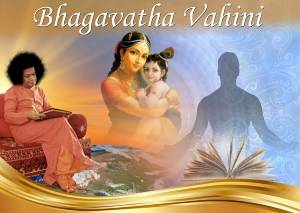 The Geetha is a central gem in the crest jewel of the great Indian epic, the Mahabharata.
Sage Vyasa wove this intricate tapestry of sublime heroism physical, mental, moral and spiritual. He had also codified the Vedic hymns and rituals. He prepared a magnificent garland of aphorisms
summarizing the basic philosophic truths. In spite of His encyclopedic scholarship and great creative skill in the realm of thought, Vyasa was afflicted by a deep inner sadness. He had no
sweetness or peace left in him.
The Geetha is a central gem in the crest jewel of the great Indian epic, the Mahabharata.
Sage Vyasa wove this intricate tapestry of sublime heroism physical, mental, moral and spiritual. He had also codified the Vedic hymns and rituals. He prepared a magnificent garland of aphorisms
summarizing the basic philosophic truths. In spite of His encyclopedic scholarship and great creative skill in the realm of thought, Vyasa was afflicted by a deep inner sadness. He had no
sweetness or peace left in him.
Narada, the sage who propagated the validity of devotion as a means of achieving bliss, had advised Vyasa to describe the glories of God, who had incarnated as Krishna. The exposition that did emerge from this advice is called the ‘Bhagavata Purana’. Baba has given it to us again in a sweeter and a more concise form as ‘Bhagavata Vahini’.
Baba's Bhagavata Vahini flows clear and cool, straight from the page to the heart. The book splendidly narrates the leelas (divine sport) of Krishna and of the dedicatory acts of those who received His Grace. It also includes the regions mapped by Vyasa under the compulsions of scholastic norms. As a result, Bhagavata Vahini is not just a book, it is a tonic, a balm, a pilgrimage, a hallelujah, a clarion call and a beacon light.
It is designed by Baba to loosen our bondage from the trivial and to tame the wildness of our minds. Vyasa's son Suka had recited the Bhagavata for the benefit of King Parikshit who had been cursed to die at the end of seven days. The recitation occupied those seven days. Since the king had filled his mind with this narrative of the glory of the Lord, he died with the name of the Lord on his lips and the form of God before his eyes.
Each one of us is under such a sentence of death, only we do not know when death will confront us. The Bhagavata Vahini can save all those who choose to be free from the fear of death and prepare them for passing beyond the realm of life, cheerfully and hopefully.
To read ‘Bhagavatha Vahini’ online, Click here.
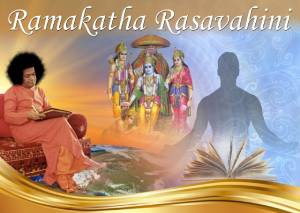 Ramakatha Rasa Vahini is a lucid narrative of Rama's life. Baba has announced that He is the same
Rama, come again to carry out His mission through his horde of followers. Drawn by His Love, we have the same good fortune now to share in his task of remoulding man after His image.
Ramakatha Rasa Vahini is a lucid narrative of Rama's life. Baba has announced that He is the same
Rama, come again to carry out His mission through his horde of followers. Drawn by His Love, we have the same good fortune now to share in his task of remoulding man after His image.
The Ramayana (or the Rama Story) is an intensely human drama where God impersonates as man and gathers around Him, on the vast world-stage, the perfect and the imperfect, the human and the subhuman, the beast and the demon, to confer on us, by precept and example, the boon of Supreme Wisdom. It is a story that plays its tender fingers on the heartstrings of man, evoking lithe, limpid responses of pathos, pity, exultation, adoration, ecstasy and surrender, rendering us transformed from the animal and the human, into the Divine, which is our core.
Sai has declared that He is the same Rama come again, and that He is searching for His erstwhile associates and workers in order to allot them roles in His present Mission of resuscitating Righteousness and leading man into the Haven of Peace. While recounting the incidents in His life as Rama, Baba has included in His narrative, certain details of dialogues and diversions not contemplated by Valmiki or any other subsequent author. He mentions many additional events and encounters, which fill the lacuna that, have long disturbed admirers of the Ramayana.
He has now deigned to tell us Himself the story of this one epic Act in that Drama, wherein He took on the Rama role. As Rama, Sai instructed, inspired and invigorated, corrected, consoled and comforted His contemporaries in the Tretha Age. As Sai Rama, He is now engaged in the same task. While reading these pages, readers will often be pleasantly struck by the identity of the Rama of this story and the Sai Rama they are witnessing.
The controversy over whether Rama is to be reckoned as a historic prince or as God Incarnate has been set to rest by Baba. The ‘Ramakatha Rasavahini’ is the very nectar of the great epic, Ramayana.
The whole volume of Rama’s story is divided into two parts. The first part deals with the story of Sri Rama from His birth till His banishment into the forest and the installation of Rama’s sandals on the throne of Ayodhya. The second part begins with the stay of Rama in the forest till the installation of Lava and Kusha on the throne of Ayodhya, the end of Ramayana.
To read ‘Rama Katha Rasa Vahini, Part-I’ online, Click here.
To read ‘Rama Katha Rasa Vahini, Part-II’ online, Click here.